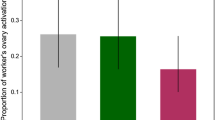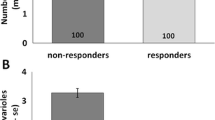Abstract
In most social insect colonies, workers do not attempt to lay eggs in the presence of a queen. However, in the honey bee (Apis mellifera), a rare phenotype occurs in which workers activate their ovaries and lay large numbers of male eggs despite the presence of a fecund queen. We examined the proximate mechanisms by which this ‘anarchistic’ behaviour is expressed. We tested the effects of brood and queen pheromones on retinue attraction and worker ovary activation using caged worker bees. We found no difference between the anarchistic and wild type queen pheromones in the retinue response elicited in either wild type or anarchistic workers. Further, we found that anarchistic queens produce a pheromone blend that is as effective at inhibiting ovary activation as the wild type queen pheromone. However, anarchistic workers are less inhibited by queen pheromones than their wild type counterparts, in a dose-dependent manner. These results show that the anarchistic phenomenon is not due to changes in the production of queen pheromones, but rather is due in part to a shift in the worker response to these queen-produced signals. In addition, we demonstrate the dose-dependent nature of the effect of queen pheromones on honey bee worker ovary activation.




Similar content being viewed by others
References
Amdam GV, Norberg K, Fondrk MK, Page RE Jr (2004) Reproductive ground plan may mediate colony-level selection effects on individual foraging behaviour in honey bees. PNAS 101:11350–11355
Arnold G, LeConte Y, Trouiller J, Hervet H, Chappe B, Masson C (1994) Inhibition of worker honeybee ovaries development by a mixture of fatty acid esters from larvae. C R Acad des Sci Paris 317:511–515
Barron AB, Oldroyd BP (2001) Social regulation of ovary activation in 'anarchistic' honey-bees (Apis mellifera). Behav Ecol Sociobiol 49:214–219
Barron AB, Oldroyd BP, Ratnieks FLW (2001) Worker reproduction in honey- bees and the anarchic syndrome. A review. Behav Ecol Sociobiol 50:199–208
Châline N, Ratnieks FLW, Bourke T (2002) Anarchy in the UK: Detailed genetic analysis of worker reproduction in a naturally-occuring British anarchistic honeybee, Apis mellifera, colony using DNA microsatellites. Mol Ecol 11:1795–1803
Dampney JR, Barron AB, Oldroyd BP (2002) Policing of adult honey bees with activated ovaries is error prone. Insectes Sociaux 49:270–274
Dampney JR, Barron AB, Oldroyd BP (2004) Measuring the cost of worker reproduction in honey bees: work tempo in an ‘anarchic’ line. Apidologie 35:83–88
Hamilton WD (1972) Altruism and related phenomenon, mainly in social insects. Ann Rev Ecol Syst 3:193–232
Hoover SER, Keeling CI, Winston ML, Slessor KN (2003) The effect of queen pheromones on worker honey bee ovary development. Naturwissenschaften 90:477–480
Hoover SER, Oldroyd BP, Wossler TC Winston ML (In press) Anarchistic queen honey bees have normal queen mandibular pheromones. Insectes Soc 52(1):6–10
Kaminski L-A, Slessor KN, Winston ML, Hay NW, Borden JH (1990) Honeybee response to queen mandibular pheromone in laboratory bioassays. J Chem Ecol 16:841–850
Keeling CI, Slessor KN, Higo HA, Winston ML (2003) New components of the honey bee (Apis mellifera L.) queen retinue pheromone. Proc Nat Acad Sci 100:4486–4491
Keller L, Nonacs P (1993) The role of queen pheromones in social insects: queen control or queen signal? Anim Behav 45:787–794
LeConte Y, Arnold G, Trouiller J, Masson C (1990) Identification of a brood pheromone in honey bees. Naturwissenschaften 77:334–336
Mohammedi A, Paris A, Crauser D, LeConte Y (1998) Effect of aliphatic esters on ovary development of queenless bees (Apis mellifera L.). Naturwissenschaften 85:455–458
Montague CE, Oldroyd BP (1998) The evolution of worker sterility in honey bees: an investigation into a behavioral mutant causing a failure of worker policing. Evolution 52:1408–1415
Neumann P, Radloff SE, Pirk CWW, Hepburn R (2003) The behaviour of drifted Cape honeybee workers (Apis mellifera capensis): predisposition for social parasitism? Apidologie 34:585–590
Oldroyd BP, Smolenski AJ, Cornuet J-M, Crozier RH (1994) Anarchy in the beehive. Nature 371:749
Oldroyd BP, Halling L, Rinderer TE (1999) Development and behaviour of anarchistic honey bees. Proc R Soc Lond B 266:1875–1878
Oldroyd BP, Ratnieks FLW (2000) Anarchistic honey bee workers evade worker policing by laying eggs that have low removal rates. Behav Ecol Sociobiol 47:268–273
Oldroyd BP, Wossler T, Ratnieks FLW (2001) Regulation of ovary activation in worker bees: larval signal production and adult response thresholds differ between anarchistic and wild-type bees. Behav Ecol Sociobiol 50: 366–370
Pankiw T, Winston M, Slessor KN (1994) Variation in worker response to honey bee (Apis mellifera L.) queen mandibular pheromone (Hymenoptera: Apidae). J Insect Behav 7:1–15
Pankiw T, Winston ML, Slessor KN (1995) Queen attendance behaviour of worker honey bees (Apis mellifera L.) that are high and low responding to queen mandibular pheromone. Ins Soc 42:371–378
Pernal SF, Currie RW (2000) Pollen quality of fresh and 1-year-old single pollen diets for worker honey bees (Apis mellifera L.). Apidologie 31:387–409
Seeley TD (1985) Honey Bee Ecology. Princeton University Press, Princeton, NJ
Slessor KN, Kaminski L-A, King GGS, Borden JH, Winston ML (1988) Semiochemical basis of the retinue response to queen honey bees. Nature 332:354–356
Visscher PK (1989) A quantitative study of worker reproduction in honey bee colonies. Behav Ecol Sociobiol 25:247–254
Visscher PK, Dukas R (1995) Honey bees recognize development of nestmates’ ovaries. Anim Behav 49:542–544
Zar JH (1984) Biostatistical Analysis, 2nd edn. Prentice-Hall inc. Englewood Cliffs, New Jersey
Acknowledgements
This research was supported by grants from the Australian Research Council to BPO, and the Canadian Natural Science and Engineering Research Council to MLW. Fellowship support was provided SERH from NSERC. We appreciate the technical assistance of C. Keeling, E. Plettner, M. Duncan, and J. Lim. B. Crespi, L. Dill, J. Woyke, and two anonymous reviewers gave us comments that greatly improved the manuscript. This study complies with the current laws of Canada and Australia.
Author information
Authors and Affiliations
Corresponding author
Additional information
Communicated by R. Page
Rights and permissions
About this article
Cite this article
Hoover, S.E.R., Winston, M.L. & Oldroyd, B.P. Retinue attraction and ovary activation: responses of wild type and anarchistic honey bees (Apis mellifera) to queen and brood pheromones. Behav Ecol Sociobiol 59, 278–284 (2005). https://doi.org/10.1007/s00265-005-0039-2
Received:
Revised:
Accepted:
Published:
Issue Date:
DOI: https://doi.org/10.1007/s00265-005-0039-2




